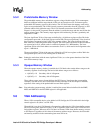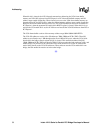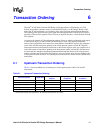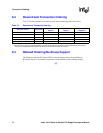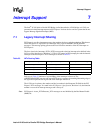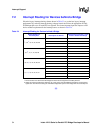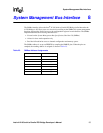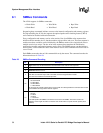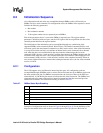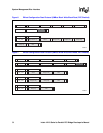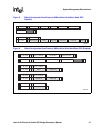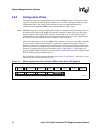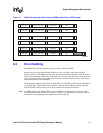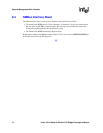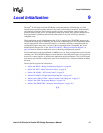
Intel
®
41210 Serial to Parallel PCI Bridge Developer’s Manual 57
System Management Bus Interface
8.2 Initialization Sequence
All configuration read and writes are accomplished through SMBus write(s) followed by an
SMBus read (for a read command). For configuration access, the SMBus write sequence is used to
initialize the following parameters:
• Bus number
• Device/function number
• 12-bit register number (in two separate bytes on SMBus)
Each of the parameters above is sent on the SMBus in separate bytes. The register number
parameter is initialized with two bytes, and the 41210 ignores the most significant four bits of the
second byte that initializes the register number.
The initialization of the information can be accomplished through any combination of the
supported SMBus write commands (Block, Word or Byte). The internal command field for each
write must specify the same internal command every time (read or write). After all the information
is set up, the last write (end bit is set) initiates an internal read or write command. On an internal
read, when the data is not available before the slave interface acknowledges this last write
command (ACK), the slave “clock stretches” until the data returns to the SMBus interface unit. On
an internal write, when the write is not complete before the slave interface acknowledges this last
write command (ACK), the slave “clock stretches” until the write completes internally. When an
error occurs (internal time-out or internal abort) during the internal access, the last write command
receives a NACK.
8.2.1 Configuration
The 41210 supports only read Dword to internal register space. All configuration reads are
accomplished through an SMBus write (or writes) and are followed later by an SMBus read to read
the status and the read data. For SMBus read transactions, the last byte of data (or the PEC byte
when enabled), is NACKed by the master to indicate the end of the transaction. The SMBus read
command returns the status of the previous internal command and the data associated previous
internal read command. The status field encoding is shown in Table 27:
Examples of configuration reads are shown in Figure 6 through Figure 9. For the definition of the
diagram conventions below, refer to the System Management Bus Specification, Revision 2.0.
Table 27. SMBus Status Byte Encoding
Bit Description
7 Internal time-out. This bit is set when an SMBus request is not completed in 2 ms internally.
6 Reserved
5 Internal master abort
4 Internal target abort
3:1 Reserved
0 Successful



